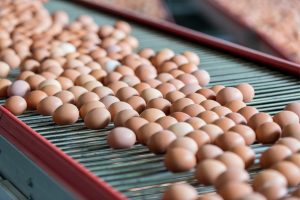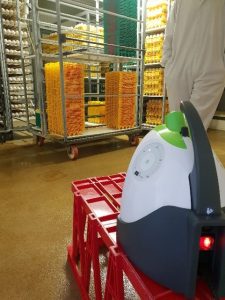Oxy’Pharm’s automated bio-disinfection of surfaces has won scientific recognition in a highly specialised area of the agricultural sector: the disinfection of hatching eggs. In just a few years, the group has gone from experimental to niche market.

Formaldehyde has been widely used as a disinfectant biocide in the poultry breeding and hatching sector for disinfecting hatching eggs… Before incubation, the aim is to protect the embryo from the risk of microbiological contamination and to preserve the sanitary quality of the finished products.
In 2004, formaldehyde was classified as a “known human carcinogen” by the International Agency for Research on Cancer. A long process of changing standards to protect exposed workers then had to be set in motion, moving gradually towards a ban.
But what can replace formaldehyde?
No more formaldehyde
In 2015, the Itavi Institute, an independent applied research body recognised by the public authorities for the poultry industry, began a series of studies aimed at researching, testing and validating alternative methods.
Five processes were tested in subsequent years, including gas-phase hydrogen peroxide, using the Nocolyse+ bio-disinfection treatment applied by Oxy’Pharm’s Nocospray diffuser.
Nocolyse+ is a biodegradable liquid solution applied via the Nocospray diffuser developed using a heating and ionising turbine to diffuse liquid Nocolyse+ transformed into gas (5 μm particles). The product is then tested according to Oxy’Pharm’s recommendations with a dosage of ≥ 5 ml /m3 of volume treated.
A trolley of hatching eggs was disinfected with a litre of product diffused in the hatchery’s disinfection room over a two-hour cycle (diffusion-contact-extraction) vs. a trolley of hatching eggs with a conventional formaldehyde treatment.
Three impact measurements were carried out :
➢ the level of contamination by total aerobic mesophilic shell flora (FAMT) and “the application of Nocolyse+ under the test conditions resulted in a significant reduction in shell FAMT contamination at the end of the two series carried out”, conclude the researchers;
➢ operator exposure in the disinfection room: the measurements are below or equal to the occupational exposure limit values (Vlep);
➢ hatching performance: disinfection of the Nocolyse+ by the Nocospray diffuser in the disinfection room or airlock under the test conditions “did not lead to any deterioration in performance compared with that obtained from the untreated control batch”.

The key to the Itavi Institute
The Itavi Institute concluded in 2017 that gas-phase Nocolyse+ “provides bactericidal efficacy close to that obtained with formaldehyde, does not generate critical exposure, has no significant effect on embryonic performance and does not impair animal growth” – another of the five processes was awarded the same seal of approval: sodium dichloroisocyanurate (DCCNa).
This was the case at the Centre avicole d’Ile-de-France (Caif), where a manager told filieres-avicoles.com: “We have come to the same conclusions as Itavi after four years of use, supervised by monthly analyses at each site”. A hatchery in Normandy is experimenting with the system, then adopting it by equipping its rooms with 18 bio-disinfection units, not to mention smaller breeders.
“Of course, our ‘medical’ expertise in disinfecting operating theatres and cleanrooms, for example, must have caught the attention of Itavi researchers at the time,” says Oxy’Pharm, “but that doesn’t mean that the problems are any less complex here, in what has become a niche market for us! This is a sector where antibiotic resistance is a major problem”.